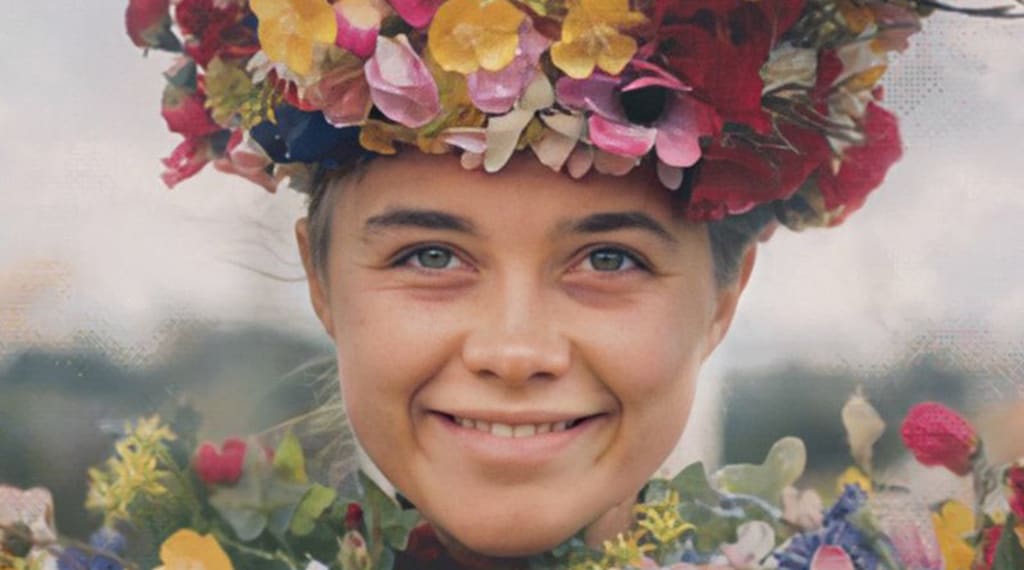Content warning
This story may contain sensitive material or discuss topics that some readers may find distressing. Reader discretion is advised. The views and opinions expressed in this story are those of the author and do not necessarily reflect the official policy or position of Vocal.
“Midsommar”: Unraveling the True Villains in the Sun-Drenched Nightmare
Everything is NOT what it seems

**NOTE: THIS REVIEW CONTAINS SPOILERS**
Ari Aster's Midsommar is a fever dream of horror and dark psychological exploration, set against the backdrop of a sun-drenched Swedish commune. While the film is filled with ritualistic ceremonies and unsettling imagery, its true horror lies in the twisted dynamics and motivations of its characters. In this thought-provoking review, we'll peel back the layers to uncover the true villains of the story.
At first glance, it's easy to identify the Hårga cult as the antagonists, luring unsuspecting outsiders into their web of rituals and sacrifice in the idyllic Hälsingland. However, a closer look reveals that the real villains might be much closer to home. Pelle, a member of the commune and a friend of the deuteragonist, Christian, plays a pivotal role in orchestrating the fateful trip to Sweden. He slyly manipulates Christian and his friends into becoming unwilling sacrifices for the cult's dark traditions along with his “brother,” Ingemar, who invited Connie and Simon. Pelle's actions are both calculating and sinister, making him a central figure in the unfolding tragedy.
But Midsommar doesn’t stop there; it goes much further in its exploration of villainy. Dani, the film's main character and proposed “protagonist,” is not exempt from scrutiny. While her actions may be driven by profound grief and emotional turmoil, she willingly sacrifices her boyfriend, Christian, to the cult. Her journey is one of profound transformation, but it's also marked by the disturbing revelation that she seeks retribution for her perceived lack of value in her relationship with Christian. Her projection of pain onto him sets the stage for the film's shocking climax.
Christian, the hapless boyfriend who becomes ensnared in the cult's sinister rituals, is certainly not portrayed as a saint. His inability to provide emotional support to Dani and his actions within the cult's community raise questions about his moral character. However, it's important to note that he may not deserve the gruesome fate that befalls him. In a film filled with dark and morally complex characters, his brutal demise remains a shocking and disturbing moment that challenges our perceptions of justice.
What truly sets Midsommar apart from conventional horror is its use of juxtaposition to create visceral and haunting sequences. The film's climax presents two scenes that are both intriguing and deeply unsettling. Dani's transformation into the May Queen is juxtaposed with the ritualistic mating scene between Christian and Maja. The Maypole dance, symbolic of fertility and abundance, stands in stark contrast to the horrifying ritual taking place in the barn.
The mating ritual is one of the film's most intense and disturbing moments. As the cult's female elders bear witness, the audience is drawn into Dani's emotional turmoil. Her screams and tears mirror the audience's own horror at the spectacle before them. It's a testament to the film's power that it can evoke such visceral reactions while delving into deeply uncomfortable territory. The juxtaposition of the two scenes forces us to confront the complex interplay between beauty and brutality in the narrative.
Despite the viscerally unsettling nature of the film's content, Midsommar offers an opportunity for profound reflection. It challenges our understanding of villainy and calls into question the blurred lines between victims and perpetrators. It underscores the idea that true horror often lies within the human psyche, in the choices we make and the pain we carry.
In conclusion, Midsommar is a masterpiece of psychological horror that transcends traditional genre boundaries. It forces us to reevaluate the concept of villainy, shedding light on the darkness that can exist within our own desires and motivations. The film's use of juxtaposition and its ability to evoke visceral reactions make it a unique and thought-provoking cinematic experience. It may be a disturbing release by Ari Aster, but it is also a work of art that challenges our preconceptions and leaves a lasting impact.
As we grapple with the morally complex characters and the horrifying climax, we are reminded that the true horror in Midsommar is not in the cult's rituals but in the depths of the human psyche. It's a nightmarish journey that will haunt you long after the credits roll.
About the Creator
Alice B. Schellinger.
Hostess of the SchellingtonGrin Podcast. Writer of poems, short stories, articles, and reviews. Support the SchellingtonGrin Podcast on Spotify and connect with me here and on other socials to be part of the Community
Enjoyed the story? Support the Creator.
Subscribe for free to receive all their stories in your feed. You could also pledge your support or give them a one-off tip, letting them know you appreciate their work.






Comments
There are no comments for this story
Be the first to respond and start the conversation.